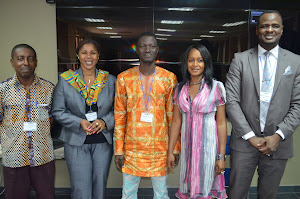BY EDMUND SMITH-ASANTE
Researchers have found that Community-based
Natural Resource Management (CBNRM) methods of conservation can inform
strategies for communities to become more resilient to climate challenges such
as droughts, floods, extreme temperatures and changes to rainfall patterns.
A report published by the International Institute
for Environmental Development (IIED) this week, says this revolutionary
approach to conservation and development pioneered in southern Africa, provides
vital lessons that can help communities worldwide adapt to climate change.
The eight key lessons identified by researchers
on CBNRM for community based adaptation, are that blending strategies for
sustainable livelihoods and resource management can make communities more
resilient and able to adapt to climate shocks, and that local capacity can
decide whether communities can overcome climate threats.
Others are that incentives must be direct
and visible, sustainable household cash incomes will enhance a community’s
capacity to adapt, community adaptation projects should build on traditional
institutions – not just create new ones, while institutions for community based
adaptation should include all relevant stakeholders.
The rest are that traditional leadership
can be an important symbol for community ownership, while trust matters between
communities and their leaders, and between leaders and project teams are vital.
According to IIED, CBNRM
is based on an incentive-driven notion that assumes that communities will
manage their natural resources better, and in ways that also result in poverty
reduction, if they are in control of those resources and derive direct economic
benefits from them.
This approach to
conservation and development, the institute says, has enabled communities to
cope with a range of stresses.
IIED also states
that four key elements form the foundations of CBNRM, which are; sustainable
use, devolution of management decisions from government to local institutions,
collective control and legal rights over resources, and economic incentives
that enhance the value of resources to communities that conserve them.
Researcher Muyeye Chambwera who together with
colleagues studied examples of Community-Based Natural Resource Management over
the past three decades to enable communities control and benefit from local
wildlife, forests, water and other resources, maintains that “CBNRM has been a
success when it has created processes and institutions that devolve power from
central government, create tangible benefits for communities and allow the
people themselves to take charge of their own development.”
Chambwera states further, that “These factors
will all be critical to the success of communities as they strive to adapt to
climate change.”
He adds that “To succeed, long-term adaptation
to climate change will depend on locally-based and proven approaches rather
than top-down interventions that are driven by central governments or outside
aid agencies, and which depend on external resources.” “That’s where CBNRM can
provide useful models for community-based adaptation. In fact both systems can
work hand-in-hand and strengthen each other,” Chambwera stresses.
After three decades of experience, CBNRM is now
operating at local, national and regional levels, but the IIED report says for
community based adaptation to climate change to become as well established at
such scales, it will need financial incentives, enabling policies, research,
communication and people who will champion the approach.






No comments:
Post a Comment